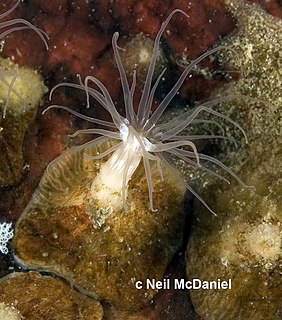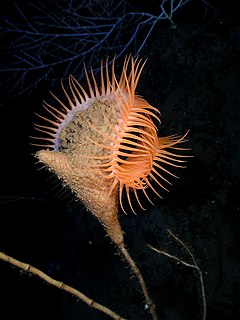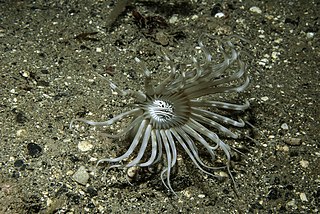
The Arctic Archipelago, also known as the Canadian Arctic Archipelago, is an archipelago lying to the north of the Canadian continental mainland, excluding Greenland.

Octineon is the sole genus of sea anemones in the monotypic family Octineonidae.

Actinoscyphiidae is a family of sea anemones.

Edwardsia is a genus of sea anemones, the type of the family Edwardsiidae. They have eight mesenteries and live in tubes in the sand. The name, in New Latin, commemorates the French zoologist Henri Milne-Edwards.

Sea anemones are the marine, predatory animals of the order Actiniaria. They are named after the anemone, a terrestrial flowering plant, because of the colourful appearance of many. Sea anemones are classified in the phylum Cnidaria, class Anthozoa, subclass Hexacorallia. As cnidarians, sea anemones are related to corals, jellyfish, tube-dwelling anemones, and Hydra. Unlike jellyfish, sea anemones do not have a medusa stage in their life cycle.

Epiactis is a genus of sea anemones in the family Actiniidae. There are about nineteen recognised species and the type species is Epiactis prolifera.

Edwardsiidae is a family of sea anemones. Edwardsiids have long thin bodies and live buried in sediments or in holes or crevices in rock.
Actinernoidea is a superfamily of sea anemones in the order Actiniaria, Until 2014, this taxon was considered to be a separate suborder of the family Actiniaria.

Metridioidea is a superfamily of sea anemones in the order Actiniaria.

Arachnanthus sarsi is a species of tube-dwelling anemone in the family Arachnactidae. This species is found in the North Atlantic in subtidal sand or muddy sand at depths of 15–130 m.

Actinostolidae is a family of sea anemones in the order Actiniaria. Members of this family are deep sea species, with some occurring at hydrothermal vents.

Actinostola is a genus of sea anemones in the order Actiniaria. All members of this genus are deep-sea species, with some occurring at hydrothermal vents.
Paranemonia vouliagmeniensis, or Greek anemone, is an endangered sea anemone that occurs only in Lake Vouliagmeni, Athens. The lake's status as a spa has contributed negatively to the species' livelihood and population; while no formal population monitoring has taken place, it has been estimated that the population has decreased by over 50% from 2007-2017. Paranemonia vouliagmeniensis has large embryos that can be found in the tentacles, unlike other species in the same genus. It also has a greater size range than other sea anemone.
Acontiophoridae is a family of sea anemones.
Aiptasiomorphidae is a family of sea anemones.
Boloceroididae is a family of sea anemones.
Haliactinidae is a family of sea anemones.
Acontiophorum is a genus of sea anemones of the family Acontiophoridae.
Limnactiniidae is a family of sea anemones belonging to the order Actiniaria.









